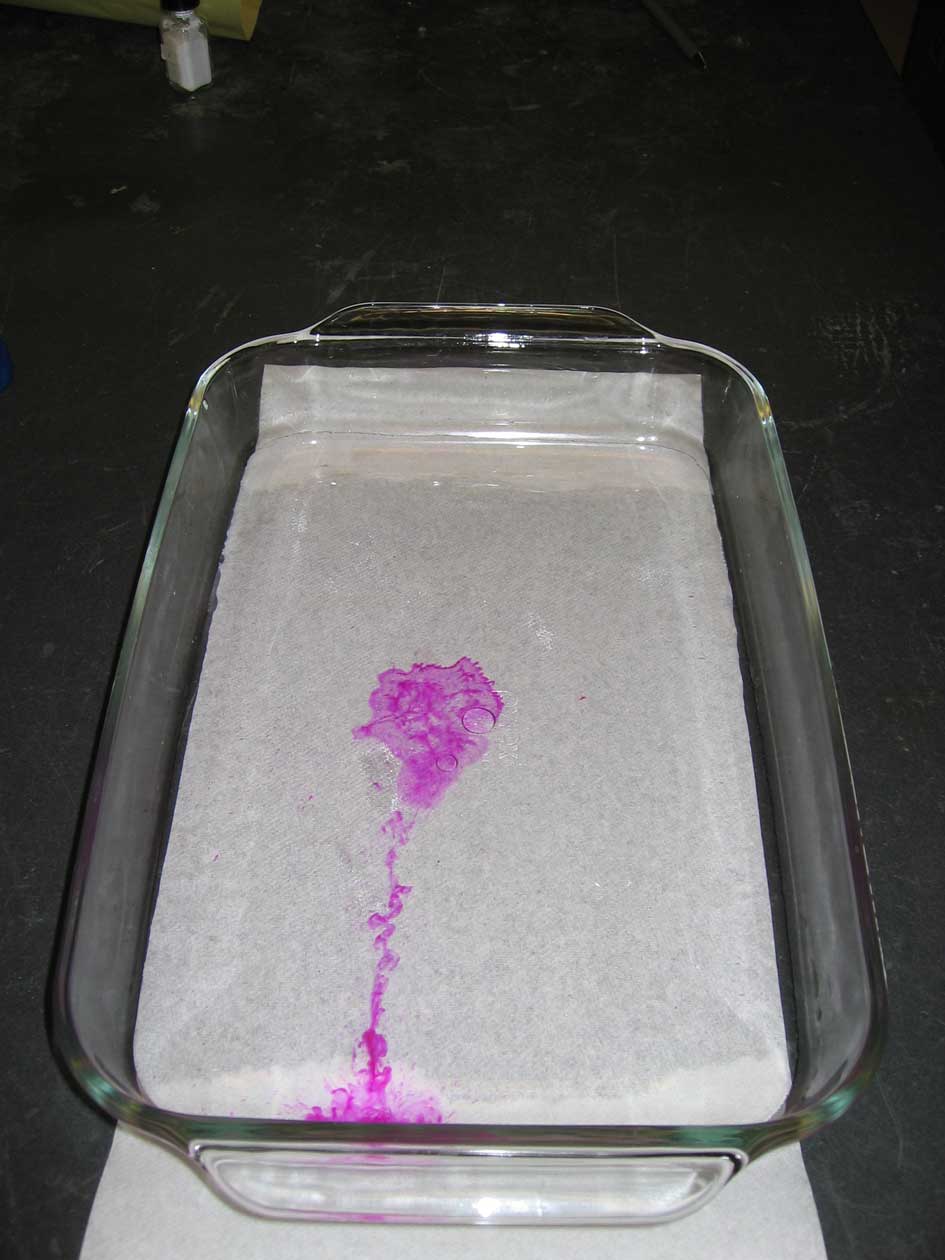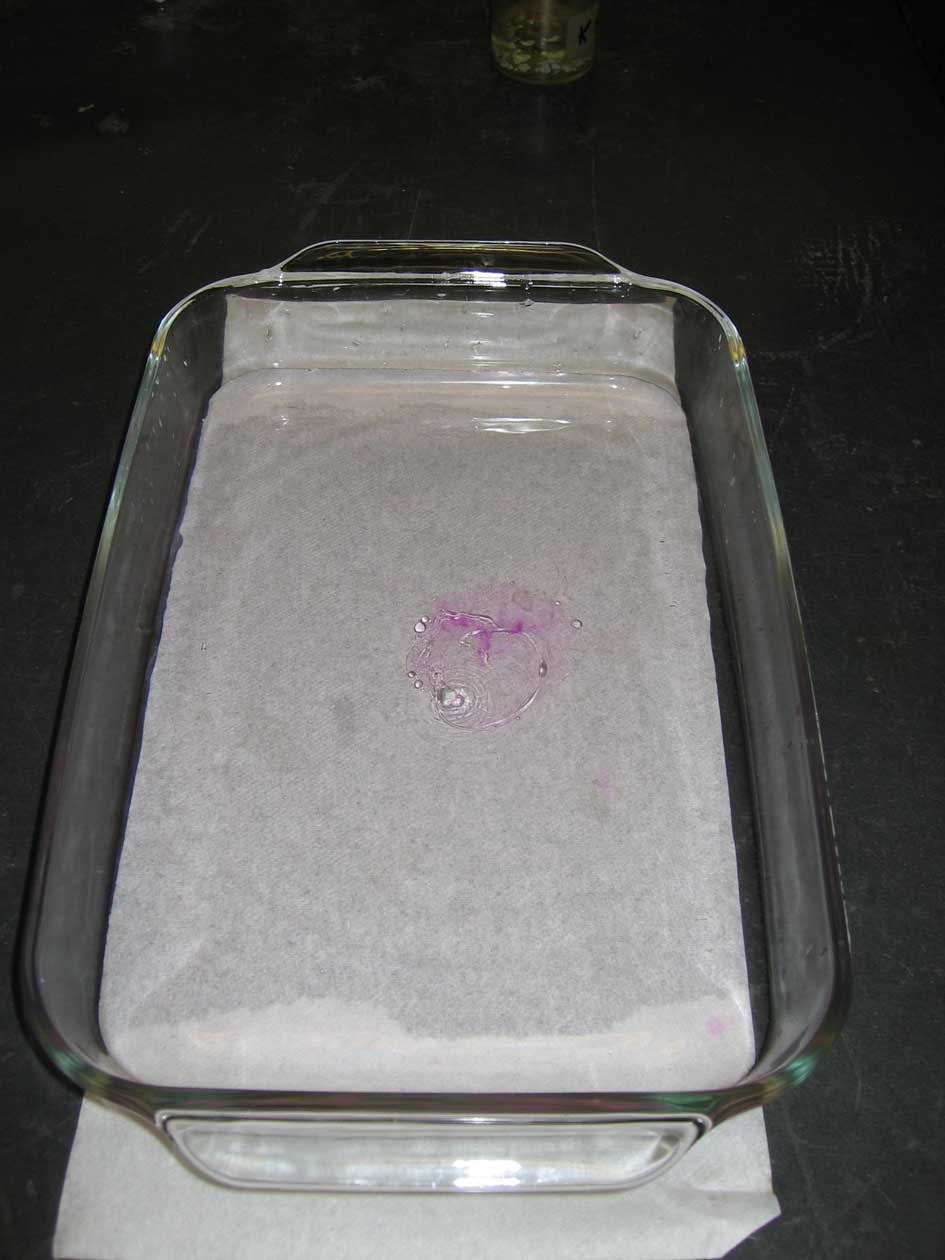Ingredients: water, sodium metal, phenolphthalein indicator
Procedure: A complete recipe follows.
1. Place water in a Pyrex plate.
2. Add phenolphthalein indicator to the water.
3. Add a small amount of sodium metal to the water and observe the reaction.
 Understanding:
Sodium is stored under mineral oil (a complex mixture of hydrocarbons) to prevent it from coming into contact with air or water. Our reaction shows us why. As the piece of sodium is introduced to the water, the reaction is immediate. Gas evolves from the reaction that occurs at the interface between the sodium and water, causing the sodium to "scoot" around the dish. The path of the sodium is marked by a pink trail.
What are the products of our reaction?
Understanding:
Sodium is stored under mineral oil (a complex mixture of hydrocarbons) to prevent it from coming into contact with air or water. Our reaction shows us why. As the piece of sodium is introduced to the water, the reaction is immediate. Gas evolves from the reaction that occurs at the interface between the sodium and water, causing the sodium to "scoot" around the dish. The path of the sodium is marked by a pink trail.
What are the products of our reaction?
A gas is produced. What is the gas? Our reactants are sodium and water. We could imagine producing oxygen gas or hydrogen gas. The gas is observed to be flammable, so it must be molecular hydrogen!
Our initially neutral solution of water and phenolphthalein indicator is clear. When the solution becomes basic, the indicator turns pink. The production of a pink trace in the path of the scooting sodium metal indicates the creation of a basic solution. What is the base? Once hydrogen gas is produced from our reaction of sodium and water, the remaining oxygen could be in the form of oxygen gas or ... hydroxide ion! The production of hydroxide ion explains the pink trace.
The balanced equation for the chemistry we observe is
2 Na(s) + 2 H2O(l) → 2 Na+(aq) + 2 OH-(aq) + H2(g)
In the Earth's environment, highly reactive sodium is typically found in its ionic state, a positively charged ion, paired with various negatively charged ions in the form of salts. The most common form is sodium chloride, otherwise known as table salt. It can be found dissolved in high concentration in the oceans, and in deposits thousands of feet thick left by the evaporation of ancient seas.

The reaction of potassium with water is compared with the reaction of sodium with water. Similarities and differences are noted in the reactivity of the two alkali metals.
Ingredients: water, sodium metal, potassium metal, phenolphthalein indicator
Procedure: A complete recipe follows.
1. After carrying out the reaction with sodium, prepare a clean Pyrex plate with water and phenolphthalein indicator.
2. Cut a small amount of potassium metal similar in size to the piece of sodium metal used.
3. Add the potassium metal to the water and observe the reaction.
 Understanding:
Similar to the reaction between water and sodium, we observe a strong reaction between the water and potassium metal. Different from the reaction of water and sodium, potassium reacts much more violently - the evolution of gas occurs at a greater rate. The potassium metal powers over the surface of the water - a hydrogen fueled boat with a wicked, flame-throwing exhaust.
Understanding:
Similar to the reaction between water and sodium, we observe a strong reaction between the water and potassium metal. Different from the reaction of water and sodium, potassium reacts much more violently - the evolution of gas occurs at a greater rate. The potassium metal powers over the surface of the water - a hydrogen fueled boat with a wicked, flame-throwing exhaust.
The balanced equation for the chemistry we observe is
2 K(s) + 2 H2O(l) → 2 K+(aq) + 2 OH-(aq) + H2(g)
The similarity in the reactivity of sodium and potassium explains why both elements were grouped as alkali metals on the Periodic Table. How do we understand the difference that we observe in the reaction? The reaction occurs by the oxidation of the alkali metal, where an electron is stolen from the alkali metal and used to reduce hydrogen, forming hydrogen gas. The potassium metal has a lower ionization energy than sodium, is more easily oxidized, and is observed to be more reactive.
What do we expect to observe if we repeat this experiment with cesium metal?
Making base
Question:
Suppose you are given 2.00 liters of water and 50.0 grams of potassium metal. You are asked to make the maximum possible volume of potassium hydroxide solution, in a 1.00 mole/liter concentration. What is the volume of your resulting solution? How many liters of water and grams of potassium were used?
 Understanding:
Sodium is stored under mineral oil (a complex mixture of hydrocarbons) to prevent it from coming into contact with air or water. Our reaction shows us why. As the piece of sodium is introduced to the water, the reaction is immediate. Gas evolves from the reaction that occurs at the interface between the sodium and water, causing the sodium to "scoot" around the dish. The path of the sodium is marked by a pink trail.
What are the products of our reaction?
Understanding:
Sodium is stored under mineral oil (a complex mixture of hydrocarbons) to prevent it from coming into contact with air or water. Our reaction shows us why. As the piece of sodium is introduced to the water, the reaction is immediate. Gas evolves from the reaction that occurs at the interface between the sodium and water, causing the sodium to "scoot" around the dish. The path of the sodium is marked by a pink trail.
What are the products of our reaction?
 The reactivity of alkali metals is explored through the reaction of sodium with water. Careful observation allows us to determine the reaction's products.
The reactivity of alkali metals is explored through the reaction of sodium with water. Careful observation allows us to determine the reaction's products.

 Understanding:
Similar to the reaction between water and sodium, we observe a strong reaction between the water and potassium metal. Different from the reaction of water and sodium, potassium reacts much more violently - the evolution of gas occurs at a greater rate. The potassium metal powers over the surface of the water - a hydrogen fueled boat with a wicked, flame-throwing exhaust.
Understanding:
Similar to the reaction between water and sodium, we observe a strong reaction between the water and potassium metal. Different from the reaction of water and sodium, potassium reacts much more violently - the evolution of gas occurs at a greater rate. The potassium metal powers over the surface of the water - a hydrogen fueled boat with a wicked, flame-throwing exhaust.